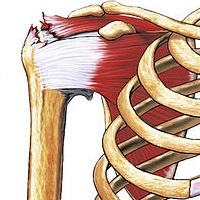
Photo from wikipedia
BACKGROUND Biceps tenodesis and tenotomy are two surgical treatment options for relief of long head of the biceps tendon (LHBT) pathology and superior labrum anterior to posterior (SLAP) tears. The… Click to show full abstract
BACKGROUND Biceps tenodesis and tenotomy are two surgical treatment options for relief of long head of the biceps tendon (LHBT) pathology and superior labrum anterior to posterior (SLAP) tears. The purpose of this systematic review was to compare the clinical outcomes and complications of biceps tenodesis and tenotomy for the treatment of LHBT or SLAP pathology during shoulder arthroscopy. METHODS A systematic review was performed by searching PubMed, the Cochrane Library, and Embase to identify Level I randomized controlled trials that compared the clinical outcomes of biceps tenodesis versus tenotomy. The search phrase used was: biceps tenodesis tenotomy randomized. Patients were assessed based on the American Shoulder and Elbow Surgeons (ASES) score, the Visual Analog Scale (VAS) for pain, the Constant-Murley score, as well as postoperative range of motion (ROM), strength, and cosmetic deformity. RESULTS Five studies (all Level I) met inclusion criteria, including 236 patients undergoing biceps tenodesis (mean age 60.3 years) and 232 patients undergoing biceps tenotomy (mean age 59.7 years). The mean follow-up was 23.0 months. Overall, 6.8% of tenodesis patients experienced cosmetic deformity at latest follow-up compared to 23.3% of tenotomy patients (p < 0.001). No differences in Constant-Murley, VAS, or ASES scores were found between groups in any study, and of all studies evaluating strength and ROM at latest follow-up, only one study found a significant difference between groups, in which tenodesis patients demonstrated significantly increased forearm supination strength (p = 0.02). One study found tenodesis patients to experience significantly more biceps cramping at 6-month follow-up compared to tenotomy patients (p = 0.043), though no differences in complication rates were found at latest follow-up in any study. CONCLUSION Patients undergoing treatment for LHBT or SLAP pathology with either biceps tenodesis or tenotomy can be expected to experience similar improvements in patient-reported and functional outcomes. There is an increased rate of cosmetic deformity in patients undergoing biceps tenotomy compared to tenodesis. LEVEL OF EVIDENCE Level I; Systematic Review and Meta-Analysis.
Journal Title: Journal of shoulder and elbow surgery
Year Published: 2020
Link to full text (if available)
Share on Social Media: Sign Up to like & get
recommendations!